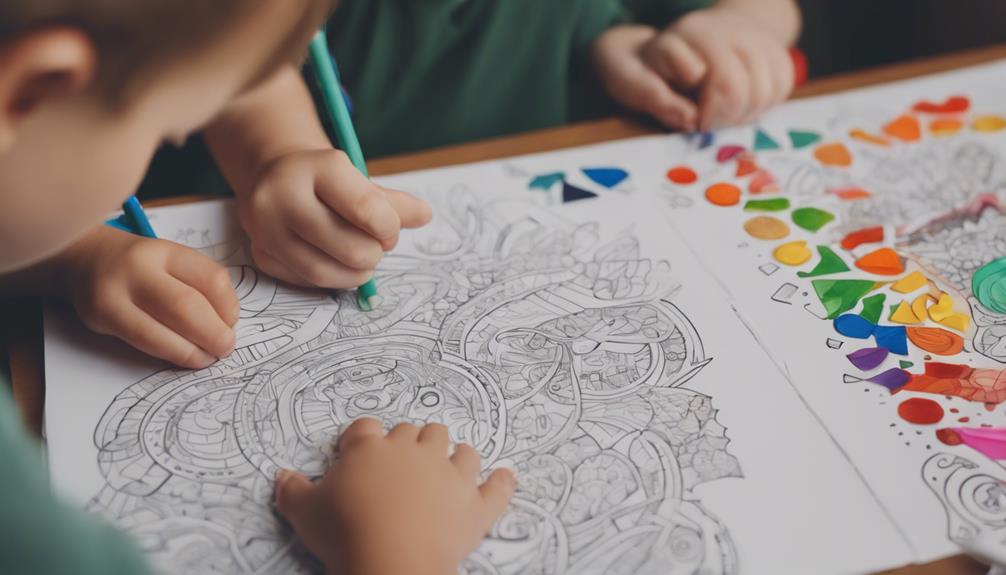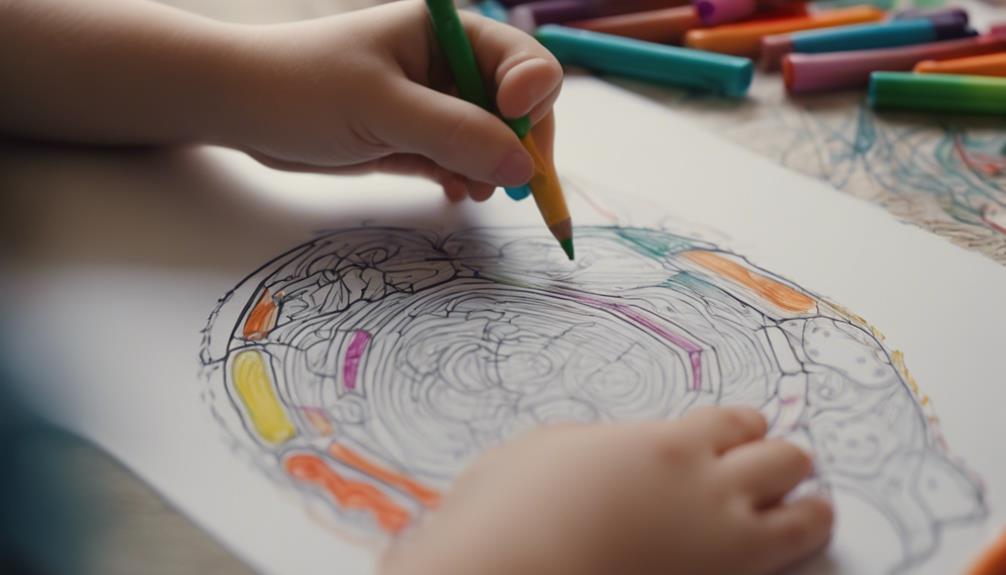When you pick up an educational coloring book, you might not realize the depth of learning that can happen with each stroke of color. The combination of engaging activities and educational content in these books goes beyond just filling in pictures.
By immersing yourself in the world of colors, shapes, and more, you open up a gateway to a myriad of benefits that extend far beyond simply staying between the lines. Each page offers a chance to explore, discover, and grow – all while having fun.
Key Takeaways
- Coloring books enhance cognitive development, creativity, and fine motor skills in children.
- Learning colors boosts brain development, supports early literacy, and stimulates artistic abilities.
- Exploring shapes through coloring encourages creativity, spatial awareness, and cognitive skills.
- Teaching numbers and counting enhances mathematical understanding, strengthens numerical abilities, and nurtures a love for numbers.
Benefits of Educational Coloring Books

Engaging in educational coloring books can enhance cognitive development in children by fostering creativity and improving fine motor skills. Through artistic expression, kids can explore a world of colors, shapes, and patterns, stimulating critical thinking and problem-solving abilities. As children color, they engage in activities that require decision-making, such as choosing colors, deciding where to start, and how to stay within the lines. These actions help develop cognitive skills and encourage logical reasoning.
Furthermore, coloring allows children to express their emotions and ideas in a visual form, promoting artistic expression and creativity. It provides a platform for kids to experiment with different color combinations, textures, and techniques, fostering innovation and originality. As children mix colors or try shading techniques, they're actively problem-solving and developing their artistic skills.
🌊 Discover Endless Fun with Beachcomber Press Puzzle Books! 🌊
Elevate your puzzle game with our captivating collection on Amazon.
Perfect for all ages, our books are packed with unique
challenges that promise hours of entertainment.
Importance of Learning Colors
Learning colors is essential for young children as it forms the foundation for understanding the world around them and aids in cognitive development. Color recognition is one of the first ways children categorize and describe what they see. By learning colors, children can communicate more effectively, enhance their creativity, and develop essential skills. Here is a table showing the importance of learning colors:
| Benefits of Learning Colors | Description | Impact |
|---|---|---|
| Enhances cognitive development | Recognizing colors helps with problem-solving and decision-making. | Boosts brain development. |
| Promotes language development | Learning color names expands vocabulary and communication skills. | Supports early literacy. |
| Encourages creativity | Mixing and matching colors fosters imagination and artistic expression. | Stimulates artistic abilities. |
| Facilitates object recognition | Associating colors with objects aids in memory and categorization. | Improves visual processing skills. |
| Develops fine motor skills | Coloring within the lines improves hand-eye coordination and dexterity. | Enhances motor skills. |
Understanding colors is not just about aesthetics; it is a fundamental aspect of a child's cognitive growth and overall development.
Exploring Shapes Through Coloring

Exploring different shapes through coloring allows young learners to grasp fundamental concepts of geometry in a creative and interactive manner. As children engage in coloring geometric patterns, they not only enhance their understanding of shapes but also develop their artistic expression. Here are three ways coloring shapes can benefit young minds:
- Encourages Creativity: Coloring geometric shapes provides a platform for children to experiment with different colors and patterns, fostering their creative expression.
- Enhances Spatial Awareness: By coloring shapes like squares, circles, and triangles, kids develop a better sense of spatial relationships and how these shapes fit together.
- Boosts Cognitive Skills: Engaging in coloring activities involving geometric patterns can improve cognitive abilities such as problem-solving and attention to detail.
Through the exploration of shapes and colors, children can unlock a world of imagination and learning, laying a strong foundation for future mathematical concepts.
Teaching Numbers and Counting
To further expand young learners' understanding of mathematical concepts, introducing them to numbers and counting through interactive activities is key. Educational coloring books provide an engaging platform for number recognition and counting practice. Visual learning is a powerful tool in developing math skills in children. By incorporating numbers into coloring exercises, kids can't only enhance their creativity but also strengthen their numerical abilities.
Coloring activities that involve counting objects or matching numbers to corresponding quantities help solidify the connection between numerals and their value. This hands-on approach makes learning numbers enjoyable and memorable. As children color pictures and count items on the page, they're actively practicing important math concepts without even realizing it.
Moreover, these activities promote cognitive development by stimulating critical thinking and problem-solving skills. Through coloring and counting, children can improve their concentration and attention to detail. By making learning interactive and fun, educational coloring books effectively nurture a love for numbers and lay a solid foundation for future mathematical success.
Enhancing Fine Motor Skills

Developing fine motor skills in children is crucial for their overall growth and development. When it comes to enhancing fine motor skills through educational coloring books, there are several key aspects to consider:
- Precision coloring techniques: Encouraging children to stay within the lines while coloring not only enhances their artistic abilities but also improves their hand-eye coordination.
- Color recognition exercises: Engaging children in activities that require them to identify and match colors can help strengthen their fine motor skills while also boosting their cognitive development.
- Fine motor development: Through activities like coloring, children can improve their finger dexterity and muscle control, which are essential for tasks like writing and tying shoelaces.
Introduction to Basic Concepts
Introducing children to basic concepts lays the foundation for their cognitive development and understanding of the world around them. Early learning experiences that focus on fundamental ideas such as colors, shapes, numbers, and sizes are crucial for young minds. These concepts serve as building blocks for more complex learning later on. By engaging in activities that introduce these basics, children develop essential skills that pave the way for future academic success.
To help you understand how early exposure to basic concepts can benefit your child, take a look at the table below:
| Basic Concept | Description |
|---|---|
| Colors | Different hues and shades |
| Shapes | Different geometric forms |
| Numbers | Counting and numerical value |
| Sizes | Big, small, tall, short |
Incorporating Fun Learning Activities

Engage your child in interactive and enjoyable learning activities that reinforce essential concepts like colors and shapes from an early age.
🌊 Discover Endless Fun with Beachcomber Press Puzzle Books! 🌊
Elevate your puzzle game with our captivating collection on Amazon.
Perfect for all ages, our books are packed with unique
challenges that promise hours of entertainment.
- Encourage Creative Expression: Provide coloring books with open-ended prompts that allow your child to explore their imagination through coloring and drawing. This fosters creativity and self-expression.
- Promote Hands-On Learning: Utilize educational play activities like shape sorting games or color matching puzzles to enhance your child's understanding of basic concepts in a fun and engaging way. Hands-on experiences solidify learning.
- Support Cognitive Development: Engaging in fun learning activities not only reinforces colors and shapes but also aids in cognitive development. Activities like memory games or pattern recognition exercises stimulate critical thinking skills in a playful manner.
Stimulating Creativity and Imagination
To spark your child's creativity and imagination, consider providing them with a variety of coloring books that offer diverse themes and prompts. Engaging in creativity exploration through coloring can significantly contribute to the development of your child's imagination. Coloring books that feature whimsical landscapes, fantastical creatures, or futuristic cityscapes can inspire your child to think beyond the ordinary and let their imagination run wild.
By presenting your child with coloring pages that aren't just limited to traditional shapes and objects but also include abstract designs, intricate patterns, and open-ended scenes, you encourage them to explore different avenues of creativity. This exploration can lead to the development of problem-solving skills, innovative thinking, and a deeper understanding of the world around them.
Through the act of coloring, children can experiment with colors, textures, and visual concepts, allowing them to express their unique perspectives and ideas in a fun and engaging way.
Engaging Educational Content

Spark your child's curiosity further by exploring coloring books that not only foster creativity but also offer engaging educational content. When selecting coloring books for your little one, consider those that provide a blend of creative expressions and hands-on learning experiences. Here are three key elements to look for:
- Interactive Activities: Seek coloring books that go beyond basic coloring pages and incorporate interactive activities like puzzles, mazes, or matching games. These activities not only enhance your child's engagement but also help develop critical thinking skills.
- Educational Themes: Opt for coloring books that introduce educational themes such as numbers, letters, shapes, and animals. These themes not only make learning fun but also aid in cognitive development.
- Fun Facts and Trivia: Look for coloring books that include fun facts and trivia related to the images being colored. This additional information sparks curiosity and encourages further exploration of the subject matter.
Interactive Learning Experience
For a dynamic and immersive learning experience, consider selecting coloring books that offer interactive elements beyond traditional coloring pages. Hands-on engagement is key in promoting active learning. Look for coloring books that incorporate interactive play through activities like puzzles, mazes, or even simple games related to the coloring theme. These interactive elements not only make the coloring experience more enjoyable but also enhance cognitive development by encouraging problem-solving skills and creativity.
Interactive learning experiences through coloring books can help children grasp concepts more effectively as they actively participate in the process. When kids are engaged in interactive play while coloring, they're more likely to retain information about colors, shapes, numbers, and other educational content. This type of engagement stimulates multiple senses, making learning more holistic and engaging. By choosing coloring books with interactive elements, you can provide a fun and enriching educational experience for children that goes beyond traditional coloring activities.
Frequently Asked Questions
Are There Any Specific Age Recommendations for Using Educational Coloring Books?
Age recommendations for educational coloring books vary, but generally, they cater to young children, typically around 2-8 years old. These books offer valuable learning benefits, aiding in color recognition, shape comprehension, and fine motor skills development.
How Can Parents or Teachers Customize Coloring Activities to Cater to Different Learning Styles?
To cater to different learning styles, think like an artist with a palette. For visual learners, use vibrant colors and bold outlines. Hands-on activities like cutting and pasting can engage kinesthetic learners. Customize to captivate!
🌊 Discover Endless Fun with Beachcomber Press Puzzle Books! 🌊
Elevate your puzzle game with our captivating collection on Amazon.
Perfect for all ages, our books are packed with unique
challenges that promise hours of entertainment.
Are There Any Tips for Incorporating Educational Coloring Books Into a Daily Routine?
To boost daily routines and enhance productivity, infuse creative learning with educational coloring books. Engage in vibrant activities, stimulating both mind and imagination. Incorporate colors, shapes, and more for a dynamic learning experience.
Can Educational Coloring Books Be Used as a Tool for Children With Special Needs or Learning Disabilities?
Yes, educational coloring books can be powerful tools for children with special needs or learning disabilities. They offer sensory integration and therapeutic benefits, enhancing visual perception and fine motor skills. Incorporating them into daily routines can support growth and development.
Are There Any Online Resources or Apps That Complement the Use of Educational Coloring Books for Additional Learning Opportunities?
Feeling curious about expanding your coloring book adventures? Dive into the digital realm! Explore a plethora of online resources and interactive apps that seamlessly complement your coloring experience, offering endless learning opportunities and creative extensions.
Conclusion
In conclusion, educational coloring books offer a plethora of benefits for young learners. By incorporating interactive activities that teach colors, shapes, numbers, and more, children can enhance their fine motor skills, creativity, and imagination.
These books provide a fun and engaging way to learn while stimulating cognitive development. Just like a painter with a palette, children can explore the world of knowledge through the vibrant pages of educational coloring books.

